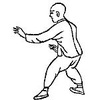FAQ
Can I come to try a class?
Sure, give a call, send a text or e-mail, and we will ascertain your needs, and set you up. After that, students are welcome to drop in on group classes, on-time, whenever they like, unless there is cancellation due to inclement weather, or holiday. There is a group mailing list so all students signed up for the list will receive notifications about cancellations. There are no sign up fees. Prices are currently $20 per class. Private lessons $75. Classes are 60-70 minutes. Wearing comfortable clothing is recommended. There are no required uniforms. Friendly environment, small group classes, all levels welcome. We accept cash, checks, and all major credit cards.
What is the difference between Qi Gong and Nei Gong?
There tends to be a lot of confusion about these two terms. Qi Gong and Nei Gong are both modern terms for the different types of exercises generally referred to as Dao Yin. Many practitioners can get lost in arguments about the distinctions between Qi Gong and Nei Gong. Let’s keep it simple: Qi Gong involves leading/following the Qi and the breath, coupled with external postures and movements, while Nei Gong merges breathing with external movements, and subtle internal movements, that move the Qi in very specific ways that change joints, bones, fascia, and the entire body. Both have civil and martial applications, but Neigong has more martial connotations, develops Shen Fa (Body Method), a skill necessary for developing and nourishing the body in very specific ways for application of internal martial arts. Both have health benefits. In Qi Gong the mind leads/follows the breath, and the energy. Nei Gong leads/follows the energy, and the internal movements of the body. Nei Gong also generally refers to exercises, and practices that change and develop the body that differ from “hard” or so called “external” styles and methods.
Should I take a private class?
Private classes are a great way to jump start the learning process for beginners, and for those students returning to practice after a long absence. Private lesson are also a convenience for those unable to attend group classes, but not a requirement. Private lessons may be useful to those students wanting to focus on one particular aspect of the practice for an entire session, which may not be possible in a group setting.
Do I have to learn about fighting?
No. Students study for various reasons. Some students come for health benefits and/or body-mind practice, some come for self defense, some attend for all of the above. Chinese internal martial arts has both civil and martial practices and applications. That said, everything taught at ElderMoon has martial or combat applications. Applications may be taught to help make the movements easier to remember, to give them a purposeful meaning, and to train the intent and awareness.
Can I cross train in other styles?
Sure, several students train or have trained in more than one martial art at a time, e.g, Muay Thai, Karate, Jujitsu, boxing, MMA and so on. We teach more than one style of internal arts. Internal arts are complementary. However, starting to learn more than one martial art at the same, regardless of style, may be difficult and confusing. It's a good idea to have proficiency or foundation in art before starting another.
Isn't Xing Yi the easiest to learn of the three major internal arts? Shouldn't I learn Xing Yi first, before Ba Gua and Taiji because they are higher order arts, and more sophisticated?
No. My teacher has written on this eloquently so I'll leave his thoughts on the matter below:
"I have heard the claim by some people that Xing Yi is the 'easiest' to learn of the three internal arts of Xing Yi, Ba Gua and Taiji, and therefore should be learned first. Without tackling the wisdom of actually trying to learn all three to any degree of skill, I have to say that I have not found that claim to be true. Perhaps it comes from the fact that even poorly learned Xing Yi, using only rough strength, can be applied with some success in combat. However, to understand Xing Yi at a high level of skill is just as difficult, if not more so, than it is with the other arts. Of all of the arts I have practiced I have found Master Li Guichang's expression of Xing Yi to be the most difficult to grasp. In my opinion it has much less room for error. It appears simple on the outside but is very difficult and deep on the inside.
Some Xing Yi practitioners also seem to have the idea that there is no retreat in the art, that there is only advancing, rolling powerfully through the enemy's center. This misconception may have arisen from when Xing Yi was taught to the army in modern times. It was felt that it was best to teach soldiers only to advance so that their mind set would be to go forward until they were told to stop. Maybe that's good for soldiers who are expendable. I don't think it's so good for the individual fighter. Classical Xing Yi has always taught strategic retreating, just as you will find in the 36 stratagems of military art. If you face a larger, stronger, and skilled enemy, it is just foolish to think that you will be able to roll through his center. If you can advance while seeming to retreat, or retreat to gain advantage, then you can overcome him."
Sure, give a call, send a text or e-mail, and we will ascertain your needs, and set you up. After that, students are welcome to drop in on group classes, on-time, whenever they like, unless there is cancellation due to inclement weather, or holiday. There is a group mailing list so all students signed up for the list will receive notifications about cancellations. There are no sign up fees. Prices are currently $20 per class. Private lessons $75. Classes are 60-70 minutes. Wearing comfortable clothing is recommended. There are no required uniforms. Friendly environment, small group classes, all levels welcome. We accept cash, checks, and all major credit cards.
What is the difference between Qi Gong and Nei Gong?
There tends to be a lot of confusion about these two terms. Qi Gong and Nei Gong are both modern terms for the different types of exercises generally referred to as Dao Yin. Many practitioners can get lost in arguments about the distinctions between Qi Gong and Nei Gong. Let’s keep it simple: Qi Gong involves leading/following the Qi and the breath, coupled with external postures and movements, while Nei Gong merges breathing with external movements, and subtle internal movements, that move the Qi in very specific ways that change joints, bones, fascia, and the entire body. Both have civil and martial applications, but Neigong has more martial connotations, develops Shen Fa (Body Method), a skill necessary for developing and nourishing the body in very specific ways for application of internal martial arts. Both have health benefits. In Qi Gong the mind leads/follows the breath, and the energy. Nei Gong leads/follows the energy, and the internal movements of the body. Nei Gong also generally refers to exercises, and practices that change and develop the body that differ from “hard” or so called “external” styles and methods.
Should I take a private class?
Private classes are a great way to jump start the learning process for beginners, and for those students returning to practice after a long absence. Private lesson are also a convenience for those unable to attend group classes, but not a requirement. Private lessons may be useful to those students wanting to focus on one particular aspect of the practice for an entire session, which may not be possible in a group setting.
Do I have to learn about fighting?
No. Students study for various reasons. Some students come for health benefits and/or body-mind practice, some come for self defense, some attend for all of the above. Chinese internal martial arts has both civil and martial practices and applications. That said, everything taught at ElderMoon has martial or combat applications. Applications may be taught to help make the movements easier to remember, to give them a purposeful meaning, and to train the intent and awareness.
Can I cross train in other styles?
Sure, several students train or have trained in more than one martial art at a time, e.g, Muay Thai, Karate, Jujitsu, boxing, MMA and so on. We teach more than one style of internal arts. Internal arts are complementary. However, starting to learn more than one martial art at the same, regardless of style, may be difficult and confusing. It's a good idea to have proficiency or foundation in art before starting another.
Isn't Xing Yi the easiest to learn of the three major internal arts? Shouldn't I learn Xing Yi first, before Ba Gua and Taiji because they are higher order arts, and more sophisticated?
No. My teacher has written on this eloquently so I'll leave his thoughts on the matter below:
"I have heard the claim by some people that Xing Yi is the 'easiest' to learn of the three internal arts of Xing Yi, Ba Gua and Taiji, and therefore should be learned first. Without tackling the wisdom of actually trying to learn all three to any degree of skill, I have to say that I have not found that claim to be true. Perhaps it comes from the fact that even poorly learned Xing Yi, using only rough strength, can be applied with some success in combat. However, to understand Xing Yi at a high level of skill is just as difficult, if not more so, than it is with the other arts. Of all of the arts I have practiced I have found Master Li Guichang's expression of Xing Yi to be the most difficult to grasp. In my opinion it has much less room for error. It appears simple on the outside but is very difficult and deep on the inside.
Some Xing Yi practitioners also seem to have the idea that there is no retreat in the art, that there is only advancing, rolling powerfully through the enemy's center. This misconception may have arisen from when Xing Yi was taught to the army in modern times. It was felt that it was best to teach soldiers only to advance so that their mind set would be to go forward until they were told to stop. Maybe that's good for soldiers who are expendable. I don't think it's so good for the individual fighter. Classical Xing Yi has always taught strategic retreating, just as you will find in the 36 stratagems of military art. If you face a larger, stronger, and skilled enemy, it is just foolish to think that you will be able to roll through his center. If you can advance while seeming to retreat, or retreat to gain advantage, then you can overcome him."

